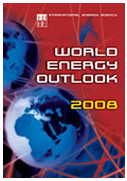Here’s another interesting article by Tim Iacono, at The Mess That Greenspan Made. Tim discusses oil, citing the IEA World Energy Outlook report. Although demand estimates are dropping, and prices have fallen, the long-term the outlook is not good. Perhaps we’re being given a final opportunity to get serious about alternative energy before the situation becomes catastrophic. – Ilene
IEA: Oil supply crunch coming
 The IEA (International Energy Agency) released their 2008 World Energy Outlook earlier today and it included a few sobering surprises.
The IEA (International Energy Agency) released their 2008 World Energy Outlook earlier today and it included a few sobering surprises.
Recall that back in early July, after the IEA released their "Medium-Term Oil Market Report" and just before the spot price of crude oil reached the unfathomable level of $147 a barrel, a post titled "We’re going to need a good recession" appeared here in which it was theorized that a big slowdown in the world economy would be needed to reduce energy price pressures in the coming years given the current trajectories of supply and demand.
Well, a lot has happened in the last four months.
The needed recession has arrived – that much is clear. Demand estimates are now being slashed with abandon, helping to pull the rug out from under the price of oil which has since tumbled more than 60 percent.
You’d think that oil market prognosticators would be happy with that development (at least the ones who are hoping there’s going to be enough of the stuff to go around for a while), but apparently they are not.
In fact, in the IEA’s latest report, they have turned downright alarmist on the subject of the long-term balance between supply and demand, acknowledging that the current system can not endure.
Here’s the opening paragraph of the Executive Summary:
The world’s energy system is at a crossroads. Current global trends in energy supply and consumption are patently unsustainable — environmentally, economically, socially. But that can — and must — be altered; there’s still time to change the road we’re on. It is not an exaggeration to claim that the future of human prosperity depends on how successfully we tackle the two central energy challenges facing us today: securing the supply of reliable and affordable energy; and effecting a rapid transformation to a low-carbon, efficient and environmentally benign system of energy supply. What is needed is nothing short of an energy revolution. This World Energy Outlook demonstrates how that might be achieved through decisive policy action and at what cost. It also describes the consequences of failure.
That sounds like pretty serious stuff, as do their price predictions of an average of $100 a barrel over the next eight years.
For the first time in a decade, they’ve actually predicted a higher energy price in the future than the current price, as indicated below in a handy chart whipped up by Nate Hagens at The Oil Drum in their initial review of the IEA report.
 They’re apparently not on board with the groundswell of opinion that Steve Forbes’ prediction of $35 oil will be a long-lasting event, if indeed it does occur (which seems increasingly likely every day).
They’re apparently not on board with the groundswell of opinion that Steve Forbes’ prediction of $35 oil will be a long-lasting event, if indeed it does occur (which seems increasingly likely every day).
There’s going to be a lot of discussion on this topic over at The Oil Drum during the next week or two – those interested in the new energy market realities may want to check in from time to time to see the latest.
Contrary to popular belief, it is high oil prices that are the cure for high oil prices, not the low oil prices that we have today. All low oil prices do is reduce infrastructure investment and exploration – why go to the trouble if you can’t pump the stuff out of the ground at a profit?
Of course if you believe that we’ve entered a deflationary black hole from which there is no escape, then $35 oil might seem pricey to you.
Nate sums up the "non-deflationary black hole" case thusly:
As has been written here often, the world’s fiat currency reserves and financial assets, which works as a system of exchange and store of value because everyone agrees that it does, nominally dwarfs the amount of real commodities. Leverage, and leverage upon leverage provided by easy credit not checked by biophysical realities unleashed a massive speculative bubble in financial asset classes in recent years.
…
Those who rationalize the recent crash in oil prices as evidence of an oil bubble are only partially correct, and miss the greater point entirely. We are in the midst of a global deleveraging of an enormous bubble in financial assets, of which oil futures contracts, is just one.
…
In sum, recent events in the real economy have put us in the liminal space where drops in demand will temporarily exceed drops in supply. Our energy future is a battle being fought between depletion and investment/technology in a world that is not only interconnected and complex but increasingly fragile. Counterintuitively to most, the lower oil prices go and the longer they stay below $80-$100 per barrel, the steeper the fall off of the crude oil plateau will be, and the dimmer our energy future.
Here, I’ll save you some time:
- liminal – of, relating to, or being an intermediate state, phase, or condition : in-between, transitional
Liminal space with no progress is not good when it comes to our energy future.
~~~~~~~~~~~~~~~~~~~~~~~~~~~~~~Advertisement~~~~~~~~~~~~~~~~~~~~~~~~~~~~~
After being quiet for many months, the marketing department is again insisting that some kind of promotion for the companion investment website be inserted into these numerous missives. After all, this could be one of the best buying opportunities in years.
Here’s the website – Iacono Research. Here’s how you request a free trial.
~~~~~~~~~~~~~~~~~~~~~~~~~~~~~~~~~~~~~~~~~~~~~~~~~~~~~~~~~~~~~~~~~~~~~


